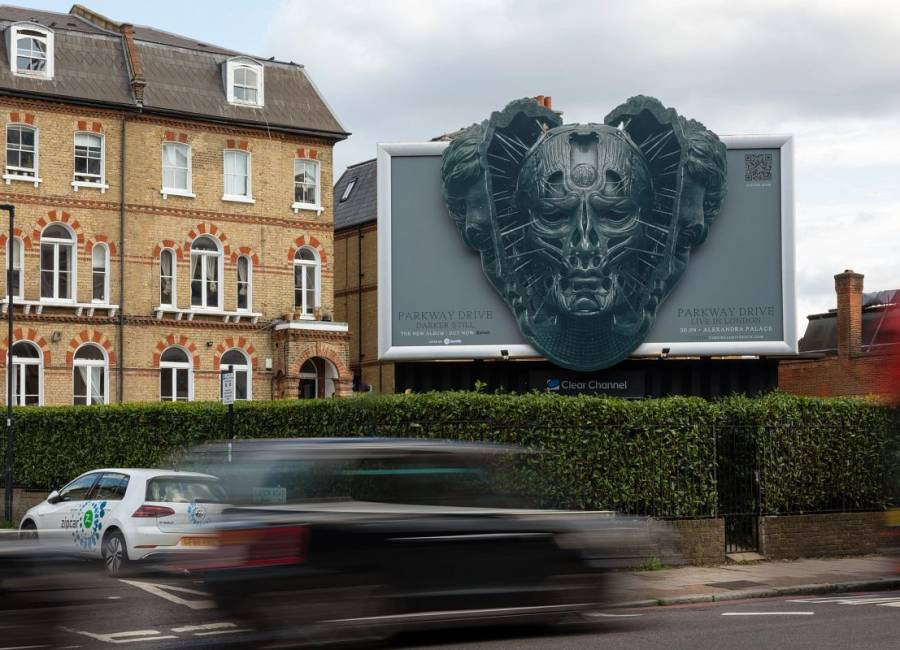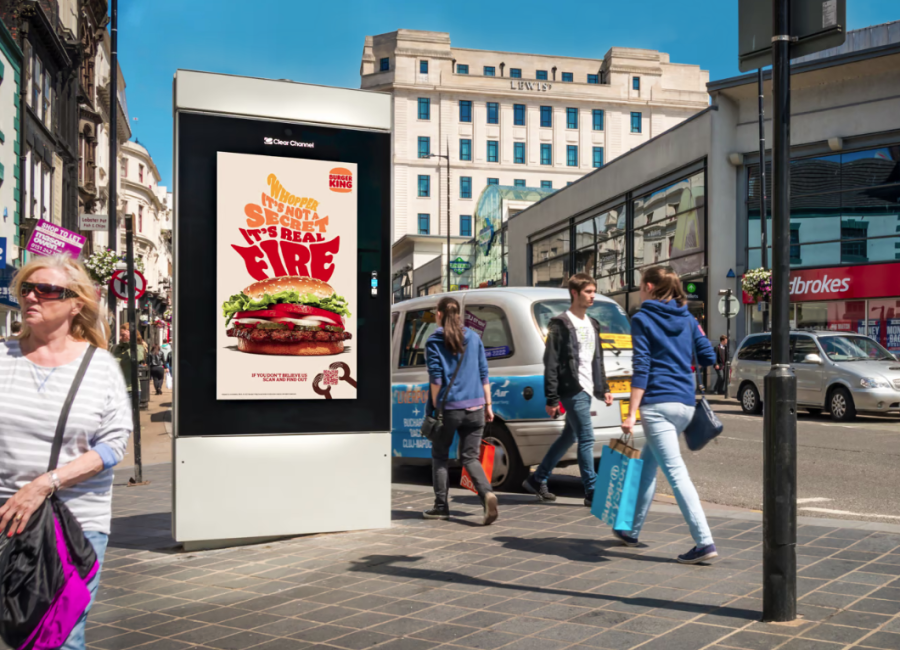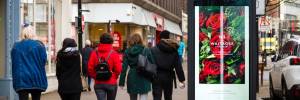Augmented Reality (AR) and Out of Home (OOH) advertising are a perfect match, capable of combining to create epic ads that capture more attention than ever before.
If you’re interested in exploring the possibilities of AR in OOH, but don’t know where to start, you’re in the right place. We’re here to explain everything you need to know about the tech, how you can implement it and what it can help you achieve.

What is Augmented Reality?
Augmented Reality allows for computer-generated imagery to be overlaid on the real world through a camera-equipped device. By using AR to integrate digital imagery with people’s surroundings, brands can create immersive interactive experiences.
AR experiences are typically exclusively visual, but they can also include audio or haptic features to create a multi-sensory experience. They’re generally facilitated on the audience side by the camera app on a smartphone or tablet.
When a user points their device’s camera at the AR target, software recognises it as the target, generates the relevant imagery, and overlays it in real-time over the target on the user’s device screen. To the user looking at the screen, the AR content looks like part of the real world.
The fact that AR merges computer-generated content with the real world is what separates it from Virtual Reality (VR). VR allows users to explore fully virtual experiences, whereas AR superimposes virtual content onto existing surroundings.
AR is used by brands for all sorts of purposes, from creating powerfully immersive 3D billboard advertisements to letting people see what a piece of furniture would look like in their home.
Augmented Reality in OOH advertising
The creative possibilities AR tech unlocks make it a great fit for brands looking to add something special to their OOH advertising campaigns.
By merging AR content with the real-world ad creative, brands get more ad space to play with. And the augmented reality part of the ad offers much more flexibility than the real-world part, opening up opportunities to integrate movement or respond to the environmental context, for example.
AR tech can be applied to all sorts of OOH formats, from 6-sheets to billboards, across both static and digital platforms. This allows brands to deploy highly engaging and immersive creative across their entire OOH and Digital Out of Home (DOOH) portfolio, adding an extra layer of depth to their campaign.
Take augmented reality billboards as an example. The real-world billboard creative can be used to hook the attention of passers-by and prompt them to activate the AR content with their smartphone. The AR content can then deliver an impactful and memorable experience that the audience takes away with them.
One of the most common approaches to integrating AR in OOH advertising is overlaying detailed 3D graphics onto or around the advertising board or screen.
This 3D content could be purely decorative, serving to make the ad more captivating. Alternatively, it could be practical, guiding users to a nearby real-world activation point like a shop location, for example.
The benefits of AR in OOH advertising
The concept of AR has been around since 1968 – meaning it’s not just a passing fad. And it’s likely that it’ll be around long into the future, too, especially AR in advertising. That’s because it offers unique benefits that can significantly increase an advertising campaign’s impact. Here are some of the most important:
Better creative opportunities
AR content can be used in diverse ways to supplement the real-world creative, combining to form multi-media ads that leave a lasting impression. The use of AR in OOH ads can be as simple as a logo hovering in front of a 6-sheet, or as complex as a scarily realistic animated 3D dragon perched on top of a billboard.
In other words, the creative possibilities AR unlocks in OOH are only limited by what brands can imagine.
More engaging and interactive
AR features in OOH ads encourage the audience to stick around for longer to get their phone out, interact with the AR scene, and see the full experience. This increases dwell time, which is the first positive, but it also ensures that the ad sticks around in the audience’s memory for longer.
The fact that AR inspires people to engage actively with ads, rather than passively taking them in as they walk by, is a powerful differentiator.
Increased contextual relevance
OOH advertising is at its best when the ad responds to the environment it’s placed in, meaning it’s more relevant to the people who see it. AR makes this more possible than ever, allowing the ad to react and interact with the environment in new ways.
This can be used to create customer activation opportunities, or simply as a way to make a stronger impact on the audience.


Some of the best AR advertising examples
AR has been used to great effect in plenty of OOH advertising campaigns, but we’ve chosen a few specific examples to show off different implementation methods.
The first is from Burger King, who used AR features activated by scanning a QR code built into their digital creative on our Adshel Live displays. Triggering the AR experience revealed a plume of smoke rising from the ad and flowing in a specific direction, leading the way to the closest restaurant.
This creative application demonstrated just one method of using AR to achieve customer activation. The smoke revealed by scanning the QR code helped Burger King to attract more customers while staying true to the creative angle of their campaign and wider brand strategy.
The second example comes from Fabyl, an independent record label, who used AR billboards to advertise the release of a Parkway Drive album. Users who pointed their AR-ready cameras at the billboard were greeted with an imposing 3D version of the album cover, with a virtual spotlight applied at night-time to add extra drama.
A QR code on the billboard also allowed users to activate the AR filter through Instagram, meaning they could project it onto the real world elsewhere. This tie-in AR feature meant the campaign got further organic reach, as users shared their own images on social media.
If you’re interested in learning more about how you can use AR to achieve your OOH creative vision and engage your audience in brand-new ways, contact our expert team today.
Start your OOH campaign today
Interested in learning more about OOH advertising? Fill in our form and one of our team will be in contact shortly to answer your questions and get started on your next campaign.



